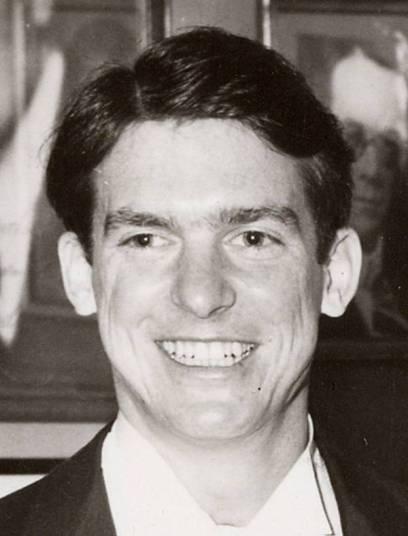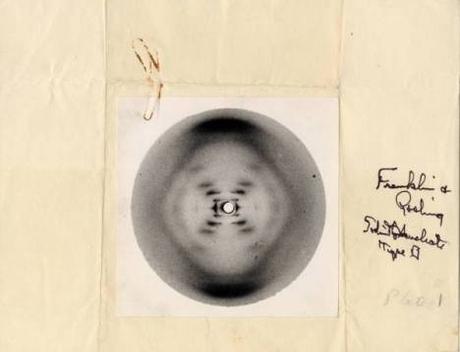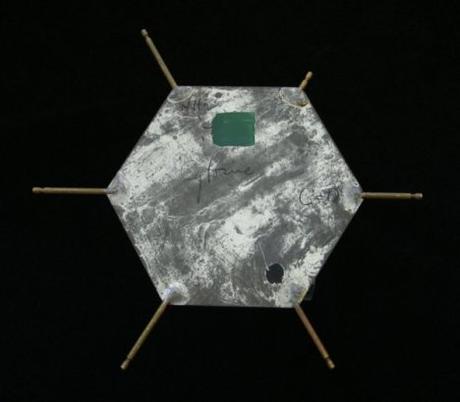
Peter Pauling, 1954.
[The life of Peter Pauling: Part 4 of 9]
With Winter break coming fast and Linus Pauling having apparently solved the structure of DNA, Jim Watson and Francis Crick extinguished any hope of modeling their own structure. Eager to take advantage of a few days off, their Cavendish office mate, Peter Pauling, headed for the continent in the company of a friend whom he described as “a mad Rhodes scholar” who had “wooed” him with his “insane plan” for exploring Europe.
On this trip, which was indeed ambitious, Peter visited Munich, Vienna, Linz, Brussels, Frankfurt, and Bavaria, hitchhiking his way from location to location. Crossing Germany, Peter saw neighborhoods still littered with the rubble of the Second World War, alongside industrious people struggling to rebuild. His mode of travel, he confessed to his mother in a letter, had seemed a better idea when its low cost was his only consideration. In person, however, spending several hours standing in or walking through the snow had a way of changing one’s priorities.
Nonetheless, the whole escapade proved a romantic adventure for the young Peter Pauling. He spent Christmas Eve in a gas house belonging to the director of an iron company somewhere in Leoben, Austria. Resting there and watching the snow fall, he wrote again to his mother:
I look out the window to the lovely white mountains. It is grand. Considering the possibilities, Christmas and your birthday [Ava Helen was born on December 24, 1903] could hardly have been spent in a nicer place. Considering impossibilities, I can think of places where I would much prefer to be. Sometimes it is sad to grow up.
https://www.dnalc.org/content/c15/15512/triple_helix.mp4
[Triple Helix animation and narration created by Cold Springs Harbor Laboratory]
With the arrival of the new year, the Cavendish researchers put their skis away, shook the snow from their coats, and resumed their work. It wasn’t long into the term before Peter learned, from two letters received in February, that his father was, in fact, having difficulty with some of the van der Waals distances hypothesized to be near the center of his DNA model. In response – and almost as an afterthought – Peter casually asked his father for a manuscript of the DNA proposal, mentioning that his coworkers in Max Perutz’ unit would like to give it a read. Upon receiving the paper, Peter promptly revealed to Watson and Crick that the Pauling-Corey model was a triple helix, a concept similar to one that Watson and Crick had developed themselves – and rejected – back in 1951.
This moment was a major turning point for Watson and Crick, who only then realized that they still had a chance to discover the structure before Linus Pauling. That said, what followed may not have been quite the race as it was made out to be after the fact. At least, Peter Pauling did not see it that way, and the casual manner in which his father interacted with him (and with others at the Cavendish) seems also to belie such a dramatization.
https://www.dnalc.org/content/c15/15451/watson546_08.mp4
[Jim Watson recalls learning of the Pauling-Corey triple helical model. Video created by Cold Springs Harbor Laboratory.]
Near the end of February 1953, while wishing his father a happy birthday, Peter noted that his office still felt that Linus’ structure required sodium to be located somewhere near the oxygens, whose negative charges would have to cancel out to hold the molecule together. “We agree that everything is a little tight,” he said, referring to the small atomic distances between Pauling’s three polynucleotide chains with phosphate groups in the middle.
As communicated in an earlier letter to his son, Linus Pauling had already identified these structural arrangements as a weakness of the model, and he was in the midst of attempting to correct the issue. Peter confided to his father that, at that time, the Cambridge office had nothing better to offer. He added simply that “We were all excited about the nucleic acid structure,” and concluded with his many thanks for the paper.
In response, Linus Pauling asked for updates on any progress that Watson and Crick were making with their own model, and casually requested that Peter also remind Watson that he should arrive for a scheduled protein conference at Caltech by September 20th. Peter clarified only that the Cavendish group had successfully built the Pauling-Corey model and that Watson and Crick had then discarded it, becoming very involved in their own efforts and “losing objectivity.” It would be up to them, Peter said, to communicate the details of their structure. Shortly thereafter, Watson and Crick sent a letter to Linus Pauling, outlining their structure and including the short article that they had submitted for publication in Nature.

Crystallographic photo of Sodium Thymonucleate, Type B. “Photo 51.” Taken by Rosalind Franklin, May 1952.
It has been well-established that Pauling and Corey made basic errors in their own modeling of the structure of DNA. But in March 1953, having no knowledge of the x-ray crystallographic photographs of DNA that had been taken by Rosalind Franklin at Kings College, Pauling felt bewildered by the certainty with which Watson and Crick had rejected his triple helical model. Upon learning its details, Pauling agreed that the double helix model was at least as likely, and he considered it to be a beautiful molecular structure, but he could not understand why his own structure was being ruled out entirely.
At the heart of his confusion lay the fact that he did not believe that any x-ray evidence existed that proved that the phosphate groups might somehow be located on the outside, rather than in the core, of the DNA molecule. Pauling did not believe that this evidence existed because he hadn’t seen it yet; crucially, Watson and Crick had. Indeed, from the point of their realization that Pauling had modeled the structure incorrectly, Watson and Crick worked fervently to once again convince Maurice Wilkins to provide them with Rosalind Franklin’s data.
(On one occasion, they met with Wilkins for lunch at the Crick home, where Peter could often be found for brunch on the weekends. On certain of these earlier brunch occasions, while in the home’s basement dining room, Watson and Crick discussed the feasibility of redoubling their efforts to model DNA while Peter, casually eating biscuits and sipping tea at the table, offered that if they didn’t do it soon, his father would take another shot at it. After the embarrassment of a failed attempt, he assured them, Linus Pauling was a strong bet to get it right the second time around.)
Within a month’s time, and with Rosalind Franklin having left his lab, Wilkins finally consented to providing Watson and Crick with all of the relevant data that he had requested. This proved to be the final piece that the duo needed in building their correct structural model of DNA.

Pauling en route to Europe, 1953.
While all of this went on, Linus himself was seemingly unconcerned by any “race” for the structure of DNA. In fact, the only racing on his mind was a jaunt across Western Europe in a new sports car.
While Watson and Crick frantically worked to unravel the secrets of DNA before Linus Pauling beat them to it, Linus Pauling himself was debating the virtues of British, German, and Italian motor vehicles. Preparing for multiple trips overseas and in the market for some new wheels, Pauling’s plan was to select a car while in Europe during the Spring for the Solvay Conference, and then to actually pick it up in August, when he and Ava Helen would return to Europe for the International Congress of Pure and Applied Chemistry in Stockholm and Uppsala. The couple would then tour the continent in style before returning to the United States on a Scandinavian freighter and driving across the country from either New York or New Orleans to their California home.
While Peter advised his father that a Jaguar Mark VII was absolutely the best buy of the season, Linus expressed a preference for the slightly more modest convertible Sunbeam-Talbot. Peter countered with the possibility of an Austin A-40 Sports 4-Seater, and Linus finally agreed to have Peter look into purchasing the car on his behalf and scheduling a delivery of sorts. Seeing that his father was finally taking the bait, Peter attempted to spring a trap: “Might you be in need of a chauffeur, mechanic, linguist, traveling companion, navigator, break repairer, tire changer, witty conversationalist etc. on your trip next summer?” he wondered. “I know just the fellow. Good friend of mine.”

A segment of the original Watson and Crick DNA model. 1953.
As the end of March rolled around and the Solvay Conference approached, Linus Pauling alerted his son to the fact that he had not made hotel reservations or, really, any plans for his visit to Cambridge. This responsibility he delegated wholly to Peter, who was somewhat distracted at the time, writing to his father about the blue sky and sun that had finally begun to break up the English winter gloom, and announcing with pride that he had gone to two balls in one week, getting along quite well with the Scandinavian girls. “As a sensible young American, I stand out in this town of pansy Englishmen,” he declared with impunity.
When Linus finally arrived at Cambridge in April, however, he found his son’s sensibilities to be somewhat lacking. Peter had in fact not made the requested hotel reservations, and while campus accommodations were fine for the son, they were not so wonderful for the elder Pauling. Watson later joked that, “the presence of foreign girls at breakfast did not compensate for the lack of hot water in his room.”
When the moment of truth finally came, Peter and his father strode into the Cavendish offices to see the model that Watson and Crick had constructed. Upon inspection, Linus reiterated the interpretation that he had given to his son earlier: the structure was certainly possible, but to be certain, Pauling would first need to see the quantitative measurements that Wilkins had provided. By way of response, Watson and Crick produced “Photo 51,” Rosalind Franklin’s now-famous image that enabled crucial measurements concerning the structure of the B-form of DNA.
Presented with this evidence, Linus Pauling quickly conceded that Watson and Crick had solved the problem. Later that night, the Paulings, together with Watson, had dinner with the Cricks at their home at Portugal Place to celebrate. To quote Watson, each “drank their share of burgundy.”
So was it a race? And if so, what was Peter Pauling’s role? Was he a double agent or an informant? Or merely an unwitting accomplice, ignorant of the full implications of his actions?
In trying to answer these questions, it is important to emphasize that, for Peter, the “race for DNA” had never been a race at all. His father, he believed, was only interested in the nucleic acids as an interesting chemical compound. Linus Pauling clearly didn’t attack the structure with the same tenacity as Watson, in particular, who regarded the genetic material as the holy grail of biology, the secret of life. As Peter would write two decades later in New Scientist
The only person who could conceivably have been racing was Jim Watson. Maurice Wilkins has never raced anyone anywhere. Francis Crick likes to pitch his brains against difficult problems… For Jim, however…the gene was the only thing in life worth bothering about and the structure of DNA was the only real problem worth solving.
In 1966, Jim Watson, then in the process of writing his book on the discovery of DNA, The Double Helix, sent Peter Pauling an early draft. His concern, he explained, was that he accurately portray Peter’s role in the entire affair; that, and he didn’t want Peter to sue him for defamation.
Peter laughed and told his old office mate that he thought it was a very good book; certainly very exciting. However, he pointed out that Watson should ask Linus Pauling for an agreement not to sue him, too. After all, Peter said, “He has more experience than I do.”
